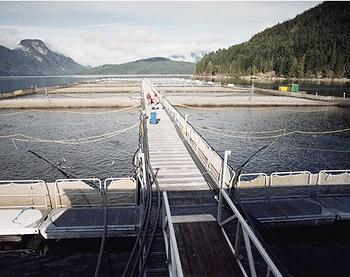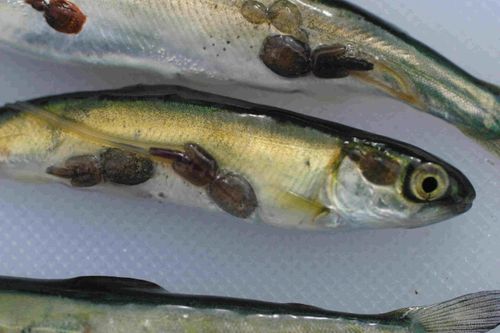NOAA Seeks Public Input for National Aquaculture Policy
WASHINGTON, DC, March 29, 2010 (ENS) – The federal government is developing a new national policy for sustainable marine aquaculture and is seeking public input to craft a set of uniform, national standards to regulate open ocean aquaculture in federal waters.
The National Oceanic and Atmospheric Administration, NOAA, will hold six listening sessions in April and May to hear recommendations from the public on how to regulate the cultivation of marine organisms, such as shellfish and finfish, with minimal damage to the environment.
Aquaculture supplies almost half of the world’s seafood and a significant portion of future increases in the global seafood supply are expected to come from aquaculture rather than from the wild-caught fisheries. The United States is a major consumer of aquaculture products, but a minor producer.
 |
Aquaculture operation in British Columbia waters (Photo courtesy B.C. Salmon Farmers Assn.) |
Currently, 84 percent of the nation’s seafood is imported, and half of that is from aquaculture. U.S. aquaculture supplies about five percent of U.S. seafood, and U.S. marine aquaculture less than 1.5 percent.
Environmental consequences of growing fish in open ocean net-cages can be extensive, threatening wild fish populations and coastal marine ecosystems.
Environmental groups including the Pure Salmon Campaign, a global project with partners in the United States, Canada, Europe, Australia and Chile, are concerned about the waste from millions of captive fish that empties into the ocean, polluting the water with untreated sewage and toxic chemicals.
An estimated three million genetically identical salmon escape from their pens each year, interbreeding with, and often out-competing populations of genetically superior wild salmon. Late last year, for instance, tens of thousands of farmed salmon escaped from open-net fish farms in British Columbia, Norway and Scotland.
Gerald Leape, senior officer at the Pew Environment Group said, “These massive escapes reinforce the point that any open ocean aquaculture legislation approved by Congress must have strong mandatory standards that prevent environmental impacts by farms that are built in U.S. waters.”
Captive farmed salmon host contagious diseases and parasites; escapees spread them to wild fish, environmentalists warn.
As they grow, farmed salmon need increasing amounts of wild caught fish for food, competing directly with humans and other fish species for this valuable yet diminishing resource. Currently, it takes the equivalent of three pounds of fish caught in the wild to make one pound of farmed salmon.
Predators such as sea lions get trapped in the net cages that enclose the farmed fish.
And marine ecologist and conservationist Alexandra Morton who studies the effect of aquaculture in British Columbia waters has documented numerous tumors on flatfish and sea lice on juvenile salmon caught near fish farms.
 |
Sea lice on juvenile salmon in British Columbia near where fish farms are located. (Photo by Alexandra Morton) |
Farmed salmon contains such high concentrations of polychlorinated biphenyls, PCBs, and other dangerous contaminants that scientists advise people to restrict their monthly intake of farmed fish.
Artificial coloring, toxic by-products, antibiotics and other drugs, and cancer-causing contaminants are present to various degrees in farmed salmon tissue, often at levels that can adversely affect human health. As early as 1999, the World Health Organization warned of the potential risks to human health from eating farmed salmon.
Yet aquaculture is the fastest growing form of food production in the world and more fish farms means more fish on dinner plates.
The largest single sector of the U.S. marine aquaculture industry is molluscan shellfish culture – oysters, clams, mussels – which accounts for about two-thirds of total U.S. marine aquaculture production, followed by salmon, about 25 percent, and shrimp, about 10 percent.
There are ways to combat some of these problems. The nonprofit Environmental Defense advises fish farmers to use closed recirculating systems to better control and treat effluents, or wastewater.
EDF suggests a holistic approach that uses seaweeds and “filter-feeders” such as mussels near fish farms to remove microorganisms and nutrients, thus improving water quality.
And the use of antibiotics and anti-parasite drugs can be minimized with measures to keep fish healthy, such as vaccinating fish and stocking ocean fish pens with small fish that naturally feed on parasites.
In NOAA’s view, two of the four major barriers to marine aquaculture are related to environmental concerns.
First, the agency is seeking to clarify the regulatory and environmental requirements for existing as well as new marine aquaculture operations, including offshore federal waters. Then NOAA is looking at developing technologies and best management practices to ensure protection of marine ecosystems.
In addition, finding suitable sites in coastal areas, where aquaculture must compete with many other coastal uses is challenging. And then the agency will address developing hatchery operations to provide fingerlings for finfish production systems.
NOAA Administrator Dr. Jane Lubchenco, a marine ecologist, is seeking to bring aquaculture squarely into NOAA’s area of responsibility.
Testifying before the House Committee on Natural Resources last September, Dr. Lubchenco said, “While the U.S. Army Corps of Engineers and the Environmental Protection Agency have some regulatory authority over siting and monitoring the water quality impacts of offshore aquaculture operations, and the U.S. Food and Drug Administration has the regulatory authority over the safety of aquaculture products, NOAA has the mandates, research portfolio, technical expertise, outreach and extension network, and appropriate infrastructure to ensure that such operations adequately safeguard our nation’s living marine resources.”
“Additionally,” she said, “because NOAA is within the Department of Commerce, it is well placed to balance the goals of developing an economically viable offshore aquaculture industry while protecting our nation’s valuable living marine resources and the ecosystems and communities they support.”
Dates for the listening sessions with NOAA officials are as follows:
- April 14 in Narragansett, Rhode Island
- April 19 in New Orleans, Louisiana
- April 22 in Seattle, Washington
- April 27 in Honolulu, Hawaii
- April 29 in Menlo Park, California
- May 6 a national call-in hosted by NOAA on a toll-free line
Details on the specific locations and times for the regional listening sessions and instructions for submitting comments electronically will be posted on the NOAA Aquaculture Program Web site http://aquaculture.noaa.gov. The agency also will accept public comment online. Instructions for submitting comments electronically will be posted on this website.
After the listening sessions, NOAA will analyze the public input and develop a draft national policy for review and another round of public comment. Once that process is complete, the agency will issue the new NOAA aquaculture policy.
Copyright Environment News Service (ENS) 2010. All rights reserved.
© 2010 – 2012, Environment News Service. All rights reserved. Content may be quoted only with proper attribution and a direct link to the original article. Full reproduction is prohibited.
